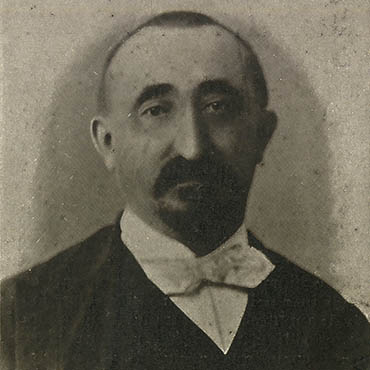Cerruti was born in 1850 at Crocemosso, nowadays in the province of Biella. After obtaining his high school diploma, thanks to a grant provided by the Collegio delle Province, he enrolled in the University of Turin, where in 1873 he graduated in civil engineering with a dissertation on Sistemi elastici articolati, published in the same year. In actual fact before his degree he had already published some articles in Giuseppe Battaglini’s “Giornale di matematiche”. After moving to Rome to work as a private tutor teaching science subjects to the children of Quintino Sella, he worked for the training school for engineers in Rome, firstly as an assistant and then as a permanent teacher of technical physics. He became assistant professor of rational mechanics in 1877 and then full professor in 1881. After Cerruti was made royal commissioner to remedy the appalling state of the Biblioteca Vittorio Emanuele, Luigi Cremona wanted him as his right-hand man. After a period of closure, the institution was reopened, completely restored. Two years later he was the one who took on the role of extraordinary commissioner for the Biblioteca Alessandrina. This was also in a parlous state, so much so that Cerruti took to court the previous director, Enrico Narducci, who, although suspended from service, managed to be acquitted from legal action.
In 1886 the Minister of Education, Michele Coppino, put Cerruti in charge of the general management of the Ministry, answering criticisms for the unusual nomination of an external aide by pointing out the particular merits of the person selected, merits which, in his view, justified the deviation from the established practice. As Chancellor of the University of Rome from 1888, he stood out for his ultraconservative approach, being hostile to any activity that could seem to him to be even vaguely subversive, from the lectures of Antonio Labriola, whom he reported, to the most “sensitive” public commemorations, like that for Guglielmo Oberdan, his former pupil. In addition to his varied university and ministerial posts, which led to his nomination as senator in 1901, he took part in the main academies, both in Italy and abroad: from the Società dei XL to the Accademia dei Lincei. As a scholar, starting with his degree dissertation, he was interested in the mathematical theory of elasticity, publishing in various academic journals and proceedings dozens of contributions, including some of a reasonably high standard. Valentino Cerruti was nominated scientific consultant for the national edition of the works of Galileo, as a replacement for Angelo Genocchi, who died shortly after being nominated. He considered his acceptance of this position as being one of “great daring, not to say temerity”, openly declaring himself to be “totally ignorant of the matter”. In actual fact, his contribution was less important than those of other consultants, but much more steady and careful, including in the resolution of bureaucratic and organisational problems, as is demonstrated by the large number of letters exchanged with Antonio Favaro. Valentino Cerruti died at Crocemosso in 1909.


